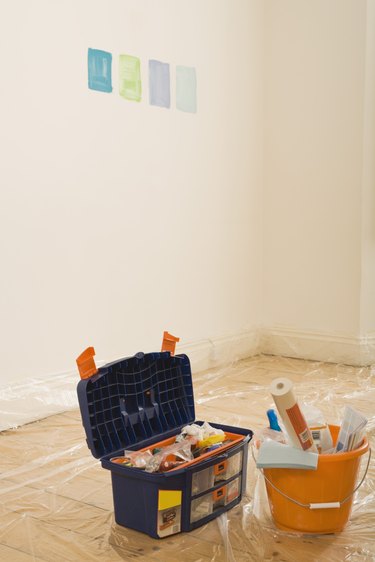
There are so many types of paints and paint finishes on the market it can be confusing to know which ones you should choose for the job you want to complete. The right combination can lead to success, while the wrong combination can go so wrong that you'll need to invest the time and expense into stripping the whole surface to start over again. Save yourself trouble and know exactly what you need before you slap that clear gloss coat on your latex finish.
Latex Paint
Video of the Day
Latex paint is a water-based paint product that comes in several finishes. Flat latex paint has no gloss but has superior pigment coverage. Eggshell has slight sheen while satin finish has a soft sheen. Semigloss and glossy latex paint have much shinier and more reflective surfaces. Certain types of paints are compatible with latex, while others are not.
Video of the Day
Clear Gloss Paint
Clear gloss paint will give a glossy shine to whatever surface on which it is painted. Clear gloss is usually an acrylic- or oil/alkyd-based sealer used to protect the surface of a painted wall, metal or masonry. In addition to protection, it lends a glossy sheen to a surface that may have originally been flat, matte or otherwise dull. Since it is clear, it will not cover or hide imperfections—the glossy finish will actually draw more attention to the problems on your painted surface.
Latex and Acrylic
Latex and acrylic are highly compatible— so much so that there are acrylic-latex paint blends available at stores that sell paint. Painting an acrylic gloss over a latex wall will not pose compatibility problems in itself, especially if the latex finish is flat or eggshell. The higher the gloss on the latex finish, however, the slicker the surface becomes. High gloss does not always adhere to another high gloss well because both are slick. The solution to remedy this problem would be to prepare the wall. Clean the satin, semigloss or glossy latex paint finish with a rag and degreaser spray. Lightly sand the finish with a super-fine grit sand paper to give the surface a "tooth" to which the clear gloss can better adhere.
Latex and Oil
The old saying that "oil and water don't mix" extends to paint jobs. Oil paints — also known as alkyd — are not generally compatible with water-based latex paint. Even when fully cured, latex is more pliable than oil paint. When humidity or temperatures change, it expands and contracts at different rates than oil paint, which leads to premature peeling and cracking of the surface. Usually changing from one type to the other would require a primer. If you want to use a clear gloss, you would first have to prime the latex wall with an oil-based primer and paint over it with oil-based paint in the desired color.